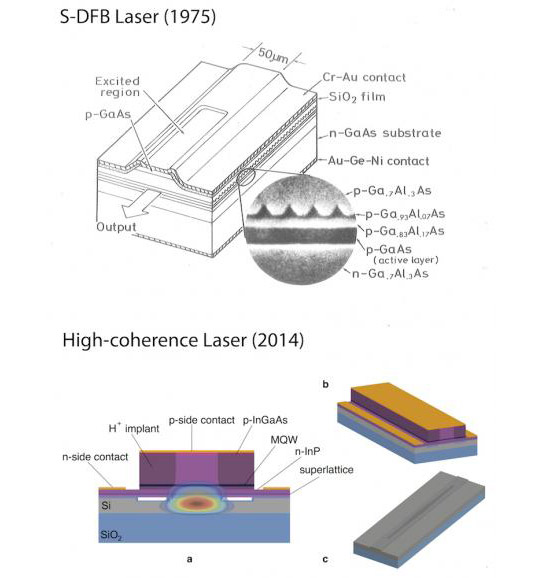- News
21 February 2014
Caltech develops high-coherence laser based on hybrid Si/III-V platform
A research group at California Institute of Technology (Caltech) has developed a new laser that is reckoned to have the potential to increase optical-fiber network data transmission rates by orders of magnitude (‘High-coherence semiconductor lasers based on integral high-Q resonators in hybrid Si/III-V platforms’, Proceedings of the National Academy of Sciences, published online 10 February).
The work is the result of a five-year effort by researchers in the laboratory of Amnon Yariv (the Martin and Eileen Summerfield Professor of Applied Physics and professor of electrical engineering). The project was led by postdoctoral scholar Christos Santis and graduate student Scott Steger.
In long-distance communications, light can carry about 10,000 times more bandwidth than microwaves. But, to utilize this potential, the laser light needs to be as spectrally pure as possible. For decades researchers have been trying to develop a laser that comes as close as possible to emitting just one frequency.
Optical-fiber networks are currently still powered by distributed-feedback semiconductor (S-DFB) lasers, developed in the mid 1970s in Yariv’s research group. The S-DFB laser’s unusual longevity in optical communications stemmed from its, at the time, unparalleled spectral purity. The laser’s increased spectral purity directly translated into greater information bandwidth of the laser beam and longer possible transmission distances in the optical fiber, hence more information could be carried further and faster than before.
At the time, this unprecedented spectral purity was a direct consequence of the incorporation of a nanoscale corrugation within the laser’s multilayered structure. The surface acts as an internal filter, discriminating against spurious ‘noisy’ waves contaminating the ideal wave frequency. Although the S-DFB laser has had a 40-year run in optical communications — and was cited as the main reason for Yariv receiving the 2010 National Medal of Science — the spectral purity (coherence) of the laser no longer satisfies the ever-increasing demand for bandwidth, says Caltech.
“Present-day laser designs — even our S-DFB laser — have an internal architecture which is unfavorable for high-spectral-purity operation,” says Yariv. “This is because they allow a large and theoretically unavoidable optical noise to commingle with the coherent laser and thus degrade its spectral purity,” he adds.
The S-DFB laser consists of continuous crystalline layers of III-V semiconductor materials — typically gallium arsenide and indium phosphide — that convert into light the applied electrical current flowing through the structure. Once generated, the light is stored within the same material. Since III-Vs are also strong light absorbers (leading to a degradation of spectral purity), the researchers sought a different solution to lossy III-V material for storing the optical energy.
Their new high-coherence laser still uses III-V materials for light generation but, in a fundamental departure from the S-DFB laser, it stores the light in a layer of silicon, which does not absorb light. Spatial patterning of this optically passive, low-loss silicon layer — a variant of the corrugated surface of the S-DFB laser — causes it to act as a light concentrator, pulling the newly generated light away from the light-absorbing III-V material and into the near-absorption-free silicon. A very high-Q resonator is hence incorporated as an integral (rather than externally coupled) part of the laser cavity.

Picture: Caltech’s high-coherence laser includes a layer of non- light-absorbing silicon. Credit: Amnon Yariv/Caltech.
The resultant high spectral purity — a 20 times narrower range of frequencies than possible with the S-DFB laser — could be especially important for the future of fiber-optic communications, it is reckoned. Originally, laser beams in optic fibers carried information in pulses of light; data signals were impressed on the beam by rapidly turning the laser on and off, and the resulting light pulses were carried through the optic fibers. However, to meet the increasing demand for bandwidth, communications system engineers are adopting the coherent phase communication method of impressing data on laser beams, which no longer requires an ‘on-off’ technique.
In coherent phase communications, the data resides in small delays (about 10-16 of a second in duration) in the arrival time of the waves, which can then accurately relay the information even over thousands of miles. Digital electronic bits (carrying video, data, or other information) are converted at the laser into these small delays in the otherwise steady light wave. But the number of possible delays, and thus the data-carrying capacity of the channel, is fundamentally limited by the degree of spectral purity of the laser beam. This purity can never be absolute — a limitation of the laws of physics — but with the new laser, Yariv and his team have tried to come as close to absolute purity as is possible.
Consequently, using a single-mode silicon resonator with a Q value of 106, the team has demonstrated a laser with a spectral linewidth of 18kHz in the telecom band (around 1.55μm).
In addition to Yariv, Santis, and Steger, other Caltech co-authors include graduate student Yaakov Vilenchik, and former graduate student Arseny Vasilyev. The lasers were fabricated at the Kavli Nanoscience Institute at Caltech. The work was funded by the US Army Research Office, the National Science Foundation (NSF), and the Defense Advanced Research Projects Agency (DARPA).
CEA-Leti and III-V lab demo fully integrated silicon photonics transmitter
Intel takes further step toward Tbit/s data transmission
Intel demos first 40GHz hybrid InP/silicon laser
First electrically pumped hybrid silicon laser
http://authors.library.caltech.edu/43855


